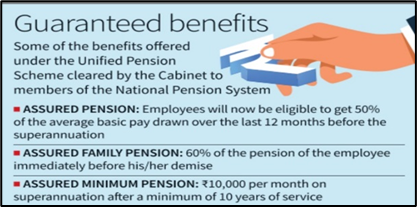Why in news?
The Union Cabinet has approved a new Unified Pension Scheme (UPS) for Central government employees, offering an assured pension of 50% of the average salary drawn over the last 12 months of service.
The UPS is similar to the Old Pension Scheme (OPS) and guarantees government employees a lifelong monthly pension of 50% of their last drawn salary.
This scheme will be optional for existing employees under the National Pension System (NPS).
What’s in today’s article?
- Old Pension Scheme (OPS)
- National Pension System (NPS)
- Difference between NPS and OPS
- Unified Pension Scheme
Old Pension Scheme (OPS)
- About
- OPS offers pensions to government employees on the basis of their last drawn salary. 50% of the last drawn salary.
- The attraction of the Old Pension Scheme lay in its promise of an assured or ‘defined’ benefit to the retiree. It was hence described as a ‘Defined Benefit Scheme’.
- E.g., if a government employee’s basic monthly salary at the time of retirement was Rs 10,000, she would be assured of a pension of Rs 5,000.
- Also, like the salaries of government employees, the monthly pay-outs of pensioners also increased with hikes in dearness allowance or DA announced by the government for serving employees.
- The OPS was discontinued by the Central government in 2003.
- Concerns with the OPS
- The main problem was that the pension liability remained unfunded — that is, there was no corpus specifically for pension, which would grow continuously and could be dipped into for payments.
- The Government of India budget provided for pensions every year; there was no clear plan on how to pay year after year in the future.
- The ‘pay-as-you-go’ scheme created inter-generational equity issues — meaning the present generation had to bear the continuously rising burden of pensioners.
- Recently, RBI red-flagged the return to the OPS by some states as a major fiscal concern.
- Several states, including Himachal Pradesh, Jharkhand, Punjab, Chhattisgarh and Rajasthan have announced a return to the OPS.
- In this regard, the RBI said “by postponing current expenses to the future, states risk accumulation of unfunded pension liabilities in the coming years”.
New Pension Scheme (NPS)
- As a substitute of OPS, the NPS was introduced by the Central government in April, 2004.
- This pension programme is open to employees from the public, private and even the unorganised sectors except those from the armed forces.
- The scheme encourages people to invest in a pension account at regular intervals during the course of their employment.
- After retirement, the subscribers can take out a certain percentage of the corpus.
- The beneficiary receives the remaining amount as a monthly pension, post-retirement.
- Nodal agency: Pension Fund Regulatory and Development Authority (PFRDA)
Difference between NPS and OPS
- The Old Pension Scheme is a pension-oriented scheme. It offers regular pensions to employees during retirement.
- Thus, in OPS, the pension amount is constant and guaranteed.
- On the other hand, the National Pension Scheme is an investment cum pension scheme.
- Therefore, NPS doesn’t guarantee fix returns as it is subjected to market volatility.
- i.e., in NPS, contributions are defined, but benefits depend on the market.
Unified Pension Scheme (UPS)
- About
- The government announced the new Unified Pension Scheme (UPS), reversing a 21-year-old civil services pension reform.
- It offers an assured pension of 50% of the average salary drawn over the last 12 months of service.
- Key features

- Effective from April 1, 2025, the scheme will be available to employees with at least 25 years of service.
- It will include benefits such as:
- a minimum pension of ₹10,000 for those with at least 10 years of service,
- inflation-linked adjustments, and
- a family pension of 60% of the employee’s pension after their death.
- The government will increase its contribution to the pension corpus from 14% to 18.5% of the basic pay and dearness allowance, while the employee contribution will remain at 10%.
- The scheme allows for a lump sum withdrawal at retirement and divides the pension corpus into two parts for investment, with a guaranteed pension based on a default investment mode.
- It will be optional for existing employees under the National Pension System (NPS.)










